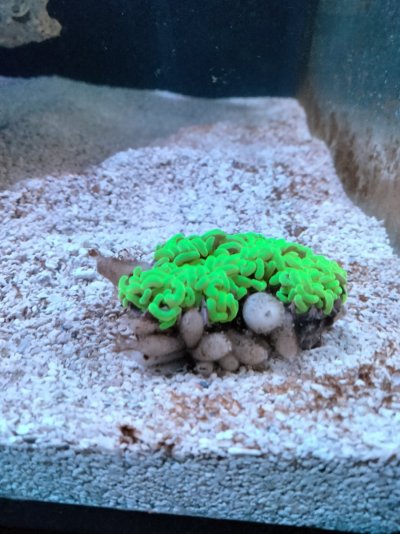Navigation
Install the app
How to install the app on iOS
Follow along with the video below to see how to install our site as a web app on your home screen.
Note: This feature may not be available in some browsers.
More options
You are using an out of date browser. It may not display this or other websites correctly.
You should upgrade or use an alternative browser.
You should upgrade or use an alternative browser.
What are these that keep bothering my hammer
The pic's a bit blurry, but those look like sponges of some variety to me. They're typically harmless filter feeders, but if they're bothering your coral, then I can see why you'd want to remove them:
ISpeakForTheSeas said:
Generally speaking, the easiest way to remove sponges is to scrape them off (the best recommendation I've seen for this is to scrape it off and suction it out).
Other suggestions include exposing the sponge to air (obviously not a guaranteed solution, and definitely not viable for this situation); hydrogen peroxide dipping the sponge (again, not viable here); injecting the sponge with hydrogen peroxide, vinegar, boiling water, or air; microbubbles in the display; and a few more. Predation is not usually a good solution for this issue, and I explain why below:
ISpeakForTheSeas said:
Yeah, unfortunately some sponges will come back basically as long as there's a piece of it left (which is why I like the recommendation to suction out as much as you can, but even that's not foolproof), so removal isn't always easy. In cases like that, the only advice I have (which may not be terribly helpful) is to try and find the cause so you can deal with the root of the problem:
ISpeakForTheSeas said:
Most sponges do, yes. If there’s a high level of silicates and a sufficient amount of food for the sponges (including things like Dissolved Organic Matter, bacteria, phytoplankton, and some Particulate Organic Matter), then you may see a population boom with sponges.
Upvote
0
They are sponges or sea squirts. Not harmful but if bothering the hammer, take it out, scrape them off with a razor blade or scalpel without scraping the hammer. Then return to DT. If you have it, I would dip the coral before returning.
Upvote
0
Very informative.The pic's a bit blurry, but those look like sponges of some variety to me. They're typically harmless filter feeders, but if they're bothering your coral, then I can see why you'd want to remove them:
Upvote
0
Glad to hear they are harmless. Will a specific cuc or fish help control it or just manually removing and keeping water clean. ThanksThe pic's a bit blurry, but those look like sponges of some variety to me. They're typically harmless filter feeders, but if they're bothering your coral, then I can see why you'd want to remove them:
Upvote
0
vetteguy53081
Well known Member and monster tank lover
View Badges
Partner Member 2024
Excellence Award
Reef Tank 365
RGB
Article Contributor
Tampa Bay Reef Keepers
West Palm Beach Reefer
Hospitality Award
Ocala Reef Club Member
305 Reef Club
Wisco Reefers
Midwest Reefer
Fish Medic
MAC of SW Florida
Rock Pool Reef Keepers
R2R Secret Santa 2023
My Tank Thread
My Aquarium Showcase
poriferan sponge and ones that will continue to grow and multiply.
Take the frag out of tank and place in a container of tank water Use a dental type pick or small crochet needle and gently pull off or scrape off with edge of a paring knife. Other option is to inject with air or vinegar via syringe which will stop it
Upvote
0
Manual removal is generally the best option for sponges:Will a specific cuc or fish help control it or just manually removing and keeping water clean. Thanks
Just to put this out there - the problem with using biological controls (i.e. something that eats it) with sponges is that there are a ton of different sponges, some of which look indistinguishable from others. Some of these sponges are inedible or extremely undesirable foods to some species (either because of chemical defenses* or just because of taste preferences) while being highly desirable to other species. So, even if you pull in a known sponge-eating species of fish/starfish/whatever, there's no guarantee it will eat the sponge you want it to eat. Also, many of these sponge-eating species eat other things (like coral) that you might not want them eating.
Long story short, manual removal is probably your best option for sponges until more study has been on both specific sponges and specific sponge-eaters, but you can try it if you want.
*Just as a note on the chemical defenses of sponges, many sponges produce chemicals to avoid being eaten. Some of these chemicals are more generalized, some of them are specifically anti-fish, some are specifically anti-echinoderm (starfish, urchin, etc.), etc. So, again, some things might eat one sponge but not another, and because of the whole indistinguishable thing mentioned above, the sponges that are and are not being eaten may look pretty much identical (some may be distinguished/ID'ed under microscopic investigation, others may need to be DNA tested to be distinguished/ID'ed).
Just my two cents here.
Upvote
0
Yes the dental pick is an awesome suggestion.poriferan sponge and ones that will continue to grow and multiply.
Take the frag out of tank and place in a container of tank water Use a dental type pick or small crochet needle and gently pull off or scrape off with edge of a paring knife. Other option is to inject with air or vinegar via syringe which will stop it
Upvote
0
Similar threads
- Replies
- 30
- Views
- 637
- Replies
- 9
- Views
- 168
















